Themed collection Spotlighting main group elements in polynuclear complexes

Spotlighting main group elements in polynuclear complexes
François Gabbaï, Cameron Jones and Connie Lu introduce the Chemical Science themed collection on the topic of main group elements in polynuclear complexes.

Chem. Sci., 2021,12, 1961-1963
https://doi.org/10.1039/D1SC90011K
Main group bimetallic partnerships for cooperative catalysis
Exporting cooperative effects in main group heterobimetallic reagents to catalytic regimes, this Perspective showcases key advances in their applications for hydroelementation, cyclisation, C–C bond formation and polymerization processes.
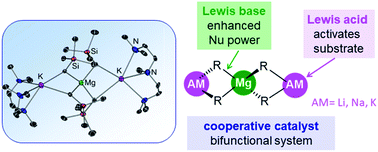
Chem. Sci., 2021,12, 1982-1992
https://doi.org/10.1039/D0SC05116K
Catalysis using transition metal complexes featuring main group metal and metalloid compounds as supporting ligands
Recent development in catalytic application of transition metal complexes having an M–E bond (E = main group metal or metalloid element), which is stabilized by a multidentate ligand, is summarized.
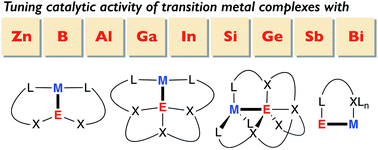
Chem. Sci., 2021,12, 1964-1981
https://doi.org/10.1039/D0SC04238B
Catalytic C–H to C–M (M = Al, Mg) bond transformations with heterometallic complexes
This highlight focuses on recent efforts to establish catalytic methods for C–H functionalisation with main group metals (M = Al, Mg).
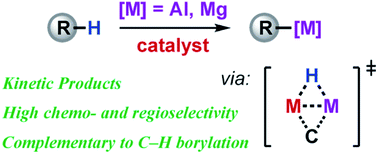
Chem. Sci., 2021,12, 1993-2000
https://doi.org/10.1039/D0SC03695A
Recent advances of group 14 dimetallenes and dimetallynes in bond activation and catalysis
This minireview highlights the recent advances in small molecule activation and catalytic applications of homonuclear dimetallenes, dimetallynes and interconnected bismetallylenes of heavier group 14 elements.
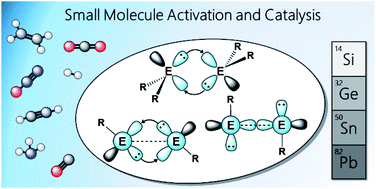
Chem. Sci., 2021,12, 2001-2015
https://doi.org/10.1039/D0SC03192E
Phosphorus-ylides: powerful substituents for the stabilization of reactive main group compounds
The application of ylide substituents as strong donor ligands for the stabilization of reactive main group compounds with unusual properties and reactivities is discussed.

Chem. Sci., 2021,12, 2016-2024
https://doi.org/10.1039/D0SC03278F
Ambiphilic boryl groups in a neutral Ni(II) complex: a new activation mode of H2
A bis(boryl)nickel complex promotes the facile and reversible activation of H2 through a cooperative mechanism that involves the metal and both boryl moieties in a concerted five-center process.
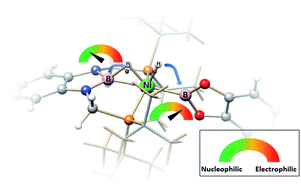
Chem. Sci., 2021,12, 2540-2548
https://doi.org/10.1039/D0SC06014C
Reversible carbon–boron bond formation at platinum centers through σ-BH complexes
A reversible carbon–boron bond formation has been observed in the reaction of the coordinatively unsaturated, cyclometalated, Pt(II) complex [Pt(ItBuiPr′)(ItBuiPr)][BArF], 1, with tricoordinated boranes HBR2.
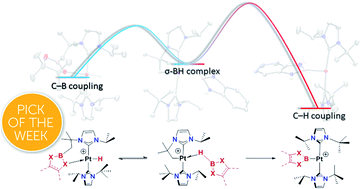
Chem. Sci., 2021,12, 1647-1655
https://doi.org/10.1039/D0SC05522K
Nucleophilic reactivity of the gold atom in a diarylborylgold(I) complex toward polar multiple bonds
A di(o-tolyl)borylgold complex added to C![[double bond, length as m-dash]](https://www.rsc.org/images/entities/char_e001.gif) O/N double bond to form Au–C and B–O/N bonds. DFT calculations revealed a two-step mechanism consisting of the coordination of O/N atom to B atom followed by nucleophilic migration of Au atom.
O/N double bond to form Au–C and B–O/N bonds. DFT calculations revealed a two-step mechanism consisting of the coordination of O/N atom to B atom followed by nucleophilic migration of Au atom.
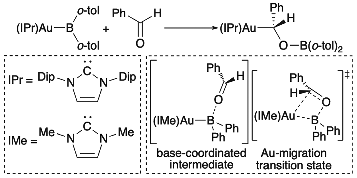
Chem. Sci., 2021,12, 917-928
https://doi.org/10.1039/D0SC05478J
Reappraising Schmidpeter's bis(iminophosphoranyl)phosphides: coordination to transition metals and bonding analysis
The synthesis, characterization and computational analysis of a range of bis(iminophosphoranyl)phosphide (BIPP) group 4 and coinage metals complexes is reported. White phosphorus was used to install the central phosphorus atom.

Chem. Sci., 2021,12, 253-269
https://doi.org/10.1039/D0SC04736H
A cyclopentadienyl functionalized silylene – a flexible ligand for Si- and C-coordination
A cyclopentadienyl functionalized silylene or its derivatives can be coordinated in all three forms: silylene (A), anion (B), and sila fulvene (C).

Chem. Sci., 2020,11, 12446-12452
https://doi.org/10.1039/D0SC04174B
Reversible addition of ethylene to a pincer-based boryl-iridium unit with the formation of a bridging ethylidene
(PBP)Ir pincer complexes containing a boryl-iridium linkage reversibly bind ethylene as an ethylidene bridging B and Ir.
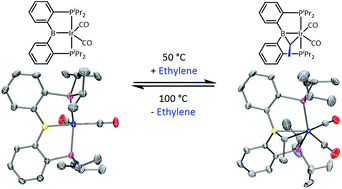
Chem. Sci., 2020,11, 10998-11002
https://doi.org/10.1039/D0SC04748A
Orbital energy mismatch engenders high-spin ground states in heterobimetallic complexes
We report a series of high spin bimetallic transition metal–tin complexes. The unusual high spin configuration in a bimetallic complex is enabled by an energetic mismatch in the orbital energies, leading to lanthanide-like nonbonding interactions.
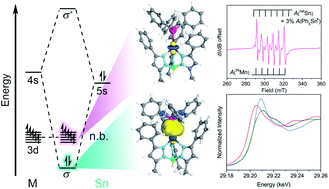
Chem. Sci., 2020,11, 9971-9977
https://doi.org/10.1039/D0SC03777J
Use of a cyclo-P4 building block – a way to networks of host–guest assemblies
A one-pot self-assembly template-controlled reaction is reported to result in a 2D coordination network of first host-guest assemblies P3Se4@[{(Cp′′Ta(CO)2(η4-P4))Ag}8]8+ of 2.49 nm in size based on an organometallic complex with a cyclo-P4 end-deck.

Chem. Sci., 2020,11, 9067-9071
https://doi.org/10.1039/D0SC03437A
Exohedral functionalization vs. core expansion of siliconoids with Group 9 metals: catalytic activity in alkene isomerization
Unprecedented metallasiliconoids are accessible from a silylene-substituted Si6 siliconoid and Group 9 metal fragments. The isomerization of terminal alkenes to 2-alkenes is competitively catalyzed by these species ( = silicon).
= silicon).
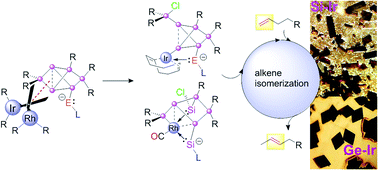
Chem. Sci., 2020,11, 7782-7788
https://doi.org/10.1039/D0SC02861D
BNN-1,3-dipoles: isolation and intramolecular cycloaddition with unactivated arenes
The mono-base-coordinated 1,2-diboranylidenehydrazine derivatives exhibiting the BNN-1,3-dipolar reactivity toward unactivated arenes and CO2 are reported.

Chem. Sci., 2020,11, 7053-7059
https://doi.org/10.1039/D0SC02162H
Heteroleptic actinocenes: a thorium(IV)–cyclobutadienyl–cyclooctatetraenyl–di-potassium-cyclooctatetraenyl complex
We report the first thorium–cyclobutadienyl complex, a new type of heteroleptic actinocene, that exhibits ‘an alkene-like’ thorium–η2-cyclooctatetraenyl interaction.
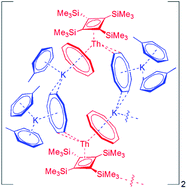
Chem. Sci., 2020,11, 6789-6794
https://doi.org/10.1039/D0SC02479A
A highly unsaturated six-vertex amido-substituted silicon cluster
Thermal treatment of the bicyclo[1.1.0]tetrasilatetraamide [Si4{N(SiMe3)Dipp}4] 1 resulted in the formation of a highly unsaturated six-vertex silicon cluster [Si6{N(SiMe3)Dipp}4] 2 with only four amine-substituents and two ligand-free silicon atoms.
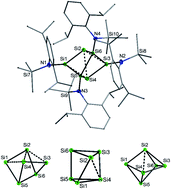
Chem. Sci., 2020,11, 5895-5901
https://doi.org/10.1039/D0SC01427C
Fulvalene as a platform for the synthesis of a dimetallic dysprosocenium single-molecule magnet
A series of fulvalene-supported dimetallic dysprosium metallocene SMMs provides a roadmap to poly-cationic dysprosocenium single-molecule magnets.

Chem. Sci., 2020,11, 5745-5752
https://doi.org/10.1039/D0SC02033H
Efficient alkene hydrosilation with bis(8-quinolyl)phosphine (NPN) nickel catalysts. The dominant role of silyl-over hydrido-nickel catalytic intermediates
A cationic nickel complex of the bis(8-quinolyl)(3,5-di-tert-butylphenoxy)phosphine (NPN) ligand, [(NPN)NiCl]+, is a precursor to efficient catalysts for the hydrosilation of alkenes with hydrosilanes under mild conditions and low catalyst loadings.
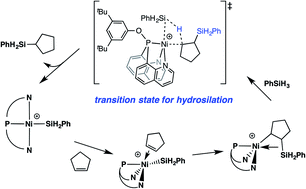
Chem. Sci., 2020,11, 5043-5051
https://doi.org/10.1039/D0SC00997K
Trends in trigonal prismatic Ln-[1]ferrocenophane complexes and discovery of a Ho3+ single-molecule magnet
Lanthanide ferrocenophanes are an intriguing class of organometallic complexes that feature rare six-coordinate trigonal prismatic coordination environments of 4f elements with close intramolecular proximity to iron ions.
![Graphical abstract: Trends in trigonal prismatic Ln-[1]ferrocenophane complexes and discovery of a Ho3+ single-molecule magnet](/en/Image/Get?imageInfo.ImageType=GA&imageInfo.ImageIdentifier.ManuscriptID=D0SC01197E&imageInfo.ImageIdentifier.Year=2020)
Chem. Sci., 2020,11, 3936-3951
https://doi.org/10.1039/D0SC01197E
Sterically controlled reductive oligomerisations of CO by activated magnesium(I) compounds: deltate vs. ethenediolate formation
Subtle changes to the bulk of 1 : 1 adducts of DMAP with magnesium(I) complexes leads to steric control over the products arising from their reductive oligomerisations of carbon monoxide.
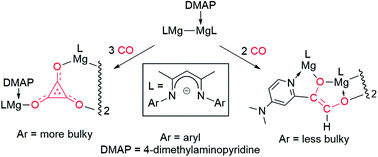
Chem. Sci., 2020,11, 3516-3522
https://doi.org/10.1039/D0SC00836B
A germaaluminocene
Boron vs. aluminum: the synthesis of a borole complex of Ge(II) is reported. Changing just the element from boron to aluminum unexpectedly yields an unprecedented neutral germaaluminocene.

Chem. Sci., 2020,11, 2982-2986
https://doi.org/10.1039/D0SC00401D
Differential uranyl(V) oxo-group bonding between the uranium and metal cations from groups 1, 2, 4, and 12; a high energy resolution X-ray absorption, computational, and synthetic study
Uranyl Pacman takes them all: the bonding of s- and d-block cations to uranyl is compared by experiment, spectroscopy and theory.
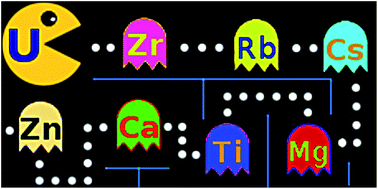
Chem. Sci., 2019,10, 9740-9751
https://doi.org/10.1039/C8SC05717F
CO2 reduction with protons and electrons at a boron-based reaction center
A redox-active borane enables CO2 reduction at boron with protons and electrons.
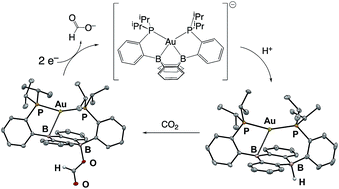
Chem. Sci., 2019,10, 9084-9090
https://doi.org/10.1039/C9SC02792K
Mild synthesis of diboryldiborenes by diboration of B–B triple bonds
A set of diboryldiborenes are prepared by the mild, catalyst-free, room-temperature diboration of the B–B triple bonds of doubly base-stabilized diborynes.

Chem. Sci., 2019,10, 7375-7378
https://doi.org/10.1039/C9SC02544H
Thermodynamic and kinetic studies of H2 and N2 binding to bimetallic nickel-group 13 complexes and neutron structure of a Ni(η2-H2) adduct
Binding energies for H2 and N2 at nickel become more exergonic for the larger group 13 sigma-accepting supports.
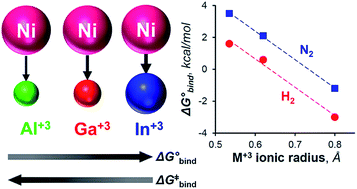
Chem. Sci., 2019,10, 7029-7042
https://doi.org/10.1039/C9SC02018G
Snapshots of magnesium-centred diborane heterolysis by an outer sphere SN2 process
Reactions of a magnesium diboranate as a source of [Bpin]− anions are initiated by ‘outer sphere’ attack of C![[double bond, length as m-dash]](https://www.rsc.org/images/entities/char_e001.gif) N bonded substrates.
N bonded substrates.

Chem. Sci., 2019,10, 6672-6682
https://doi.org/10.1039/C9SC02087J
Tuning ligand field strength with pendent Lewis acids: access to high spin iron hydrides
Pendent borane Lewis acids provide an avenue for changing a ligand's field strength through acid/base interactions; this strategy was highlighted within a series of biologically-relevant high spin iron hydrides.
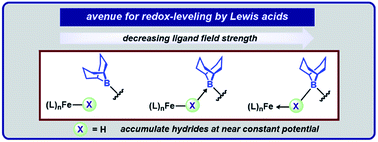
Chem. Sci., 2019,10, 5539-5545
https://doi.org/10.1039/C9SC00561G
Heterodinuclear zinc and magnesium catalysts for epoxide/CO2 ring opening copolymerizations
Eight heterodinuclear catalysts comprising Zn(II) and Mg(II) metal centres show high activity and selectivity for CO2/epoxide ring-opening copolymerization. Detailed kinetic analyses are reported and a chain-shuttling mechanistic hypothesis proposed.
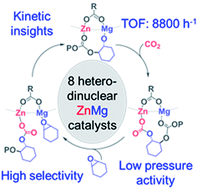
Chem. Sci., 2019,10, 4618-4627
https://doi.org/10.1039/C9SC00385A
About this collection
Associate Editor François Gabbaï and Guest Editors Cameron Jones and Connie Lu introduce this themed collection on the topic of main group elements in polynuclear complexes. This collection is made up of a selection of previously published Edge content that has been carefully selected by François, Cameron and Connie, to showcase what they feel represent recent achievements towards the incorporation of main group elements in polynuclear motifs or in the coordination sphere of transition metals, while at the same time illustrating far-reaching applications in the areas of small molecule activation, catalysis and molecular magnetism.
This collection also features some specially curated review content on the topics of Group 14 dimetallenes and dimetallynes, phosphorus-ylides, main group metal and metalloid ligands, cooperative catalysis, and magnesium and aluminium reductants in C–H bond activation.